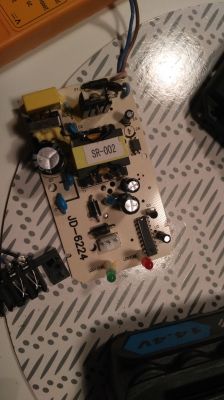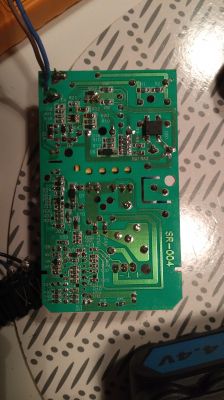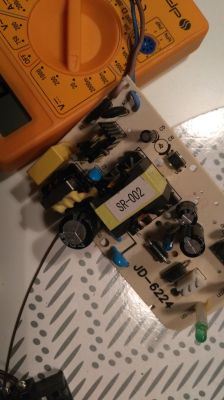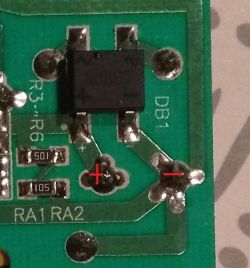FAQ
TL;DR: Dead MacAllister charger? Expect ~320 V DC on the primary electrolytic; if zero, start at F1. "The fuse should be checked with a multimeter." Use continuity mode, then verify the bulk‑cap voltage before chasing the controller. [Elektroda, wojtek 9007, #17238577]
Why it matters: This FAQ helps DIYers diagnose no‑LED/no‑charge SMPS chargers safely and decide when repair vs replacement makes sense.
Quick Facts
- Primary bulk capacitor should read approx. 320 V DC at 230 V AC input; zero indicates an input‑stage fault. [Elektroda, wojtek 9007, #17238577]
- F1 on this board is the input fuse; it’s marked on the PCB and should be tested first. [Elektroda, wojtek 9007, #17237572]
- Smart chargers may refuse to start if the battery shows no voltage at its contacts. [Elektroda, automobilklub, post #17238137]
- Replacing a blown fuse without fixing root cause often results in an immediate re‑blow. [Elektroda, Anonymous, post #17287746]
- Checking the controller IC requires its datasheet; power diagnosis may need an oscilloscope. [Elektroda, bearq, post #17261660]
How do I quickly check if my MacAllister charger�s primary is alive?
Start with two checks. 1) Test F1 with continuity (diode/buzzer) mode. 2) Measure DC across the large primary electrolytic. Expect about 320 V DC on 230 V mains. If the fuse is open or the capacitor reads 0 V, the input stage is down. Then trace input parts before suspecting the controller. [Elektroda, wojtek 9007, #17238577]
Which part is F1 on this charger and how do I locate it?
Look for the silkscreen "F1" on the PCB near the AC input section. It’s designated as the fuse on this board. Visually inspect it and then confirm with a multimeter continuity test. Replace like‑for‑like after diagnosing what caused it to blow. [Elektroda, wojtek 9007, #17237572]
What multimeter reading shows a good vs blown fuse?
Use continuity (buzzer) or diode test. A good fuse beeps and shows a low resistance path. An open fuse gives no beep and shows open circuit. Do not rely on measuring AC voltage across the fuse to decide its state. Always remove power before testing. [Elektroda, wojtek 9007, #17238577]
My meter shows �1� on the fuse; is it blown?
Yes. On many meters, a steady "1" or "OL" indicates an open circuit. That reading on F1 means the fuse element is broken. Replace it only after checking the rest of the input stage for shorts, or it may fail again on power‑up. [Elektroda, margosmat, post #17238856]
What voltage should be on the big primary electrolytic capacitor?
Measure DC across its terminals with the unit powered. On 230 V AC, you should see about 320 V DC. If you read 0 V, the rectified HV bus is missing. Suspect the fuse, input resistor/thermistor, or bridge rectifier before the switching controller. [Elektroda, wojtek 9007, #17238577]
Why won�t the charger start when the battery is at 0 V?
Many chargers need to sense a nonzero pack voltage to enable charging. If the pack is collapsed to 0 V, the charger may not activate its output or LEDs. Pre‑charge the pack or test with a known good battery to rule this out. [Elektroda, automobilklub, post #17238137]
I replaced the fuse and the charger still doesn�t start� what next?
Recheck the new fuse; it may have blown instantly due to an unresolved fault. Inspect the input path and rectifier before powering again. Power up only after isolating shorts to avoid repeat failures and further damage. [Elektroda, Anonymous, post #17287746]
How do I check the controller IC (�scalak�) power safely?
Identify the IC and obtain its datasheet to locate the VCC/startup pins. Verify the supply with a multimeter; use an oscilloscope if needed for startup pulses. "You check what the scalak is, look for its documentation on the internet." [Elektroda, bearq, post #17261660]
Can I realistically repair this charger at home with basic tools?
It’s challenging without experience and proper instruments. Live‑mains SMPS work carries shock and fire risk. If you lack measurement skills and tools, replacement is safer and faster than trial‑and‑error repair. [Elektroda, bearq, post #17237405]
Do I need an oscilloscope to diagnose a no�start converter?
Often yes, once input faults are excluded. You may need to view startup behavior on the controller VCC and gate drive. That helps confirm whether the controller attempts to run or is latched off. [Elektroda, bearq, post #17261660]
Is measuring ~14.75 V at the battery contacts meaningful if LEDs are off?
Users reported ~14.75 V at the contacts with LEDs dark. Treat it as a clue, not a verdict. Continue by confirming the HV bus and fuse status to understand if the primary is alive or the indicator path failed. [Elektroda, margosmat, post #17238557]
When should I stop troubleshooting and just buy a replacement charger?
If the fuse re�blows, there’s no 320 V on the bulk cap, and you lack an oscilloscope or datasheet, replacement is practical. The charger is available separately from the retailer for a quick fix. [Elektroda, margosmat, post #17304740]










